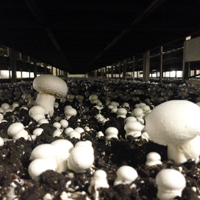Evaluation of energy requirements of an industrial scale plant for the cultivation of white button mushroom (Agaricus bisporus)

All claims expressed in this article are solely those of the authors and do not necessarily represent those of their affiliated organizations, or those of the publisher, the editors and the reviewers. Any product that may be evaluated in this article or claim that may be made by its manufacturer is not guaranteed or endorsed by the publisher.
Authors
The white button mushroom (Agaricus bisporus) industry is paying attention to innovation for a more sustainable production and it is getting sophisticated to reach high grade of energetic efficiency coupled with high quality product. For mushroom cultivation the environmental conditions must be controlled therefore in some phases the heat needs to be provided and in other ones it needs to be removed. The objective of this study was to investigate the current growing methodology used at an industrial mushroom farm site for a quantification of energy consumption. Mushroom growing parameters such as temperature and relative humidity were monitored during the production process placing sensors for a continuous data recording of these parameters in different and crucial positions throughout the entire production cycle. Heat is massively produced by the compost/mycelium system and the goal was to quantify the amount of energy needed to remove it through a cooling system and a forced air system that pulls cold air in the cultivation room and picks up the warmer and more humid air. Often, the heat produced by the cultivation room is not enough to reach the optimal growth conditions. In this case the application of an air heating system is necessary. The study was focused on evaluating the energy exchanges during a 41-day period corresponding to a growth cycle of three flushes to quantify the energy requirements of the conditioning system. A total energy of 5483 kWh/cycle was quantified for a mushroom production of 25,000 kg, corresponding to a specific energy requirement of 0.22 kWh/kg, 0.18 for cooling and 0.04 for heating. Results showed that the electric power consumption represents a crucial cost for the mushroom production, therefore an optimization of the energy requirements of the production plant is desirable and it can lead to relevant economic savings. A scenario considering a more efficient air conditioning system was proposed for a more sustainable mushroom production.














